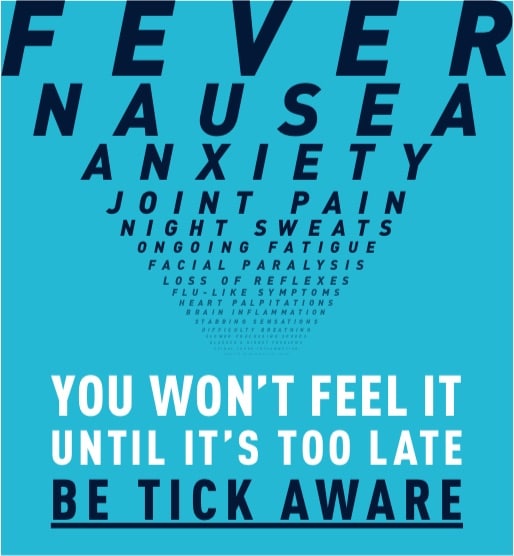May Is Lyme Disease Awareness Month

Recognizing a cause’s milestones by designating it as a weeklong or monthlong observation usually falls into one of two categories. May 6 through 12, for example, was National Nurses Week — a weeklong celebration of all things related to nurses and the nursing profession. The other category focuses on awareness, in this case, with the entire month of May, which is recognized as Lyme disease Awareness Month.
What’s particularly unnerving about Lyme disease is the simple fact that most sufferers don’t even remember being bitten by a tick. 70 percent of those infected with Lyme disease have no recollection of coming under attack by one or more of these immature ticks called nymphs.

That’s primarily because these tiny pests — no bigger than a poppy seed — can unobtrusively attach themselves to your body and catch a meal and free transportation for 36 to 48 hours, completely unobserved. That’s just enough time for the tick’s bacterium to spread, and yet another reason why anyone wandering outdoors must check themselves for tiny ticks at every opportunity.
According to the Centers for Disease Control and Prevention (CDC), the Lyme disease bacterium — called Borrelia burgdorferi — is spread to humans through a black-legged tick bite either from the Ixodes scapularis tick in the mid-Atlantic and north-central United States or by the Ixodes Pacificus tick on the Pacific Coast.
And while the CDC’s latest report reveals a total of 42,743 confirmed and probable cases of Lyme disease, the organization is quick to point out that about 300,000 people might be infected each year. Other disease experts believe CDC numbers are too low, adding that summer flu-like symptoms of the disease make it difficult to diagnose — especially in children.
Lyme Disease Symptoms
Early detection of Lyme disease can make a difference in treating the disease effectively. Symptoms occurring within the first three days to a month may include:
- Erythema migrans (EM)— a rash that may begin at the site of a tick bite and gradually expand over days and can reach 12 inches or more in diameter. Common in only 20 percent of infected individuals, EM often looks like a ring or “bull’s-eye” and can appear on any area of the body. For those affected, the EM rash is rarely itchy, though it may feel warm to the touch.
- Fever
- Chills
- Headache
- Fatigue
- Muscle and joint aches
- Swollen lymph nodes
So often, the early signs of Lyme disease are overlooked because — as alluded to above — the disease is similar to the “summer flu.” Children infected by Lyme disease may present with almost undetectable and extremely mild symptoms. These include irritability, difficulty in concentration, and a lethargy that translates to little interest in playing outdoors. These symptoms — even when detected — often lead to a misdiagnosis of attention deficit disorder (ADD) or are written off as “growing pains.”
If left untreated, the infection will penetrate the skin and can lead to numerous symptoms throughout the body. Some of these symptoms include:
- Stiff neck with severe headaches
- Erythema migrans rashes on other parts of the body
- Arthritis, knee, and other large joint pain and swelling
- Bell’s palsy
- Pain in muscles, joints, bones, and tendons
- Irregular heartbeat or heart palpitations (Lyme carditis)
- Nerve pain
- Numbness
- Neurological symptoms that may include short-term memory loss, vision changes, inability to concentrate
- Ringing or buzzing in the ear
Diagnosis and Treatment of Lyme Disease
Early diagnosis and treatment is critical in order to effectively treat Lyme disease, but is limited by the often faulty or inadequate testing of Lyme disease — especially by conventional doctors — in its early stages. For example, a recent study by Lymedisease.org reveals that half of more than 4,000 participants received a delayed or missed diagnosis due to faulty testing.
One difficulty in diagnosing Lyme disease is the symptomatic similarities it shares with a variety of other illnesses, including Alzheimer’s, arthritis, lupus, fibromyalgia, chronic fatigue syndrome, and multiple sclerosis (MS). Here at Restoration Healthcare, regardless of whether it’s Lyme disease Awareness Month or any other time of the year, we work with patients to achieve a proper diagnosis. If caught early enough, antibiotics may be the first course of action, but it is important to maintain a proper internal balance for the body to fight the disease.
If Lyme disease is not diagnosed at an early stage, antibiotics may not be the proper treatment. Under our care, and depending on a variety of individual factors — all of which are related to you as a patient that’s unlike any other patient we may treat — our treatment plan may include:
- Dietary evaluation and adjustment that address food allergies or sensitivities that weaken the immune system if not addressed
- Stress management
- Nutritional supplements with antibiotic properties aimed at improving the body’s immune system
- The need for pre-and pro-biotics in establishing and maintaining a healthy gut
- A safe and supervised medical detox program to reduce toxins in the body
- Evaluation of sleep habits and suggestions for improving sleep
If you are new to Southern California or believe you may have Lyme disease, trust your gut and fill out our New Patient Packet. We are skilled and passionate about diagnosing and treating Lyme disease.

